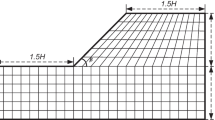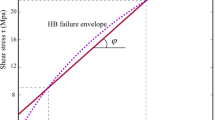Abstract
In slope stability analysis, the Mohr–Coulomb (MC) criterion is usually adopted, however, it has some limitations with regard to the rock mass description. Then the Hoek–Brown (HB) criterion was created and then widely used, and the equivalent Mohr–Coulomb (MC) parameters were proposed. However, the consistency of the HB and equivalent MC parameters in calculating slope safety factor remains to be further explored and confirmed. In this study, the gravity increase method and HB parameters were combined to analyze slope stability, and the calculation results of safety factor were compared with those of equivalent MC parameters in the same conditions. This approach was conducted to explore the parameter equivalence by analyzing the consistency of the two safety factors. Then, the HB parameters and slope height (H), which can cause the safety factor distinction (∆Fs), were studied, and the expression of ∆Fs to influencing factors was tested to examine their relationship. The results indicate the following: (1) The HB and equivalent MC parameters are not completely consistent in calculating the slope safety factor, unless the safety factor is relatively small. (2) The sensitivity of the HB parameters to ∆Fs is GSI > D > mi >σci. Moreover, when H is 20 m or 30 m, each HB parameter is linearly related with ∆Fs, in which GSI, mi, and σci are positively correlated with ∆Fs, while D is negatively correlated. (3) The H is found to be in an inversely proportional relationship with ∆Fs. The ∆Fs decreased in a slow downward trend as the H increased. Simultaneously, the linear relationship between HB parameters and ∆Fs is gradually destroyed by the increase of H.







Similar content being viewed by others
References
Alejano LR, Ferrero AM, Ramírez-Oyanguren P, Álvarez Fernández MI (2011) Comparison of limit-equilibrium, numerical and physical models of wall slope stability. Int J Rock Mech Min Sci 48:16–26
Bai B, Yuan W (2014) Li XC. A new double reduction method for slope stability analysis. J Cent South Univ 21:1158–1164
Baker R, Tanaka Y (1999) A convenient alternative representation of Taylor’s stability chart. 253–7
Benz T, Schwab R, Kauther RA, Vermeer PAA (2008) Hoek-Brown criterion with intrinsic material strength factorization. Int J Rock Mech Min Sci 45:210–222
Berisavljevic Z, Berisavljevic D, Cebasek V (2015) Shear strength properties of Dimitrovgrad flysch, southeastern Serbia. Bull Eng Geol Environ 74:759–773
Fu W, Liao Y (2010) Non-linear shear strength reduction technique in slope stability calculation. Comput Geotech 37:288–298
Hoek E, Brown ET (1988) The Hoek-Brown failure criterion-a 1988 update. J Heuristics 16:167–188
Hoek E, Brown E (1997) Practical estimates of rock mass strength. Int J Rock Mech Min Sci 34:1165–1186
Hoek E, Carranza-Torres C, Corkum B (2002) Hoek-Brown failure criterion-2002 edition. Proceedings of NARMS-TAC:267–273
Jiang XY, Cui P (2016) Liu CZ. A chart-based seismic stability analysis method for rock slopes using Hoek-Brown failure criterion. Eng Geol 209:196–208
Jiang X, Wang Z, Liu L, Zhou Z (2013) The determination of reduction ratio factor in homogeneous soil-slope with finite element double strength reduction method. Open Civil Engineering Journal 7:205–209
Jiang QH, Qi ZF, Wei W, Zhou CB (2015) Stability assessment of a high rock slope by strength reduction finite element method. Bull Eng Geol Environ 74:1153–1162
Li AJ, Merifield RS, Lyamin AV (2008) Stability charts for rock slopes based on the Hoek–Brown failure criterion. Int J Rock Mech Min Sci 45:689–700
Li LC, Tang CA, Zhu WC, Liang ZZ (2009) Numerical analysis of slope stability based on the gravity increase method. Comput Geotech 36:1246–1258
Lin H, Chen J (2017) Back analysis method of homogeneous slope at critical state. KSCE J Civ Eng 21:670–675
Lin H, Cao P, Li JT, Wang J (2008) The indirect calculation method for the safety factor of slope based on generalized Hoek-Brown criterion. J China Coal Soc 33:1147–1151
Lin H, Wang H, Fan X, Cao P, Zhou K (2017) Particle size distribution effects on deformation properties of graded aggregate base under cyclic loading. Eur J Environ Civ Eng:1–18
Marinos P, Hoek E (2001) Estimating the geotechnical properties of heterogeneous rock masses such as flysch. Bull Eng Geol Environ 60:85–92
Michalowski RL (2002) Stability charts for uniform slopes. J Geotech Geoenviron 128:351–355
Pantelidis L, Griffiths DV (2012) Stability assessment of slopes using different factoring strategies. J Geotech Geoenviron Eng 138:1158–1160
Shen JY, Karakus M (2012a) Determination of Mohr–coulomb shear strength parameters from generalized Hoek–Brown criterion for slope stability analysis. Rock Mech Rock Eng 45:123–129
Shen JY, Karakus M (2012b) Xu CS. Direct expressions for linearization of shear strength envelopes given by the generalized Hoek-Brown criterion using genetic programming. Comput Geotech 44:139–146
Song K, Yan E, Mao W, Zhang T (2012) Determination of shear strength reduction factor for generalized Hoek-Brown criterion. Chin J Rock Mech Eng 31:106–112
Sonmez H, Ulusay R (1999) Modifications to the geological strength index (GSI) and their applicability to stability of slopes. Int J Rock Mech Min Sci 36:743–760
Sternik K (2013) Comparison of slope stability predictions by gravity increase and shear strength reduction methods. Australian Journal of Physiotherapy 53:132–134
Swan CC, Seo YK (1999) Limit state analysis of earthen slopes using dual continuum/FEM approaches. Int J Numer Anal Methods Geomech 23:1359–1371
Thaweeboon S, Dasri R, Sartkaew S, Fuenkajorn K (2017) Strength and deformability of small-scale rock mass models under large confinements. Bull Eng Geol Environ 76:1129–1141
Xu WY, Xiao W (2007) Study on slope failure criterion based on strength reduction and gravity increase method. Yantu Lixue/Rock and Soil Mechanics 28:505–511
Xu NW, Dai F, Zhou Z, Jiang P, Zhao T (2016) Microseismicity and its time-frequency characteristics of the left bank slope at the Jinping first-stage hydropower station during reservoir impoundment. Environ Earth Sci 75:608
Yang XL, Wang JM, Sui ZR (2008) Stability analysis of tunnel surrounding rock based on Hoek-Brown yield criterion. Journal of Railway Science & Engineering 5:37–40
Zhang Q, Jiang BS, Wu XS, Zhang HQ, Han LJ (2012) Elasto-plastic coupling analysis of circular openings in elasto-brittle-plastic rock mass. Theor Appl Fract Mech 60:60–67
Zhang K, Tan P, Ma G, Cao P. Modeling of the progressive failure of an overhang slope subject to differential weathering in three gorges reservoir, China. Landslides. 2015;13:1–11
Zheng H, Sun G, Liu D (2009) A practical procedure for searching critical slip surfaces of slopes based on the strength reduction technique. Comput Geotech 36:1–5
Zhou XP, Bi J (2012) Zonal disintegration mechanism of cross-anisotropic rock mass around a deep circular tunnel under dynamic unloading. Theor Appl Fract Mech 60:15–22
Zhou XP, Li JL (2011) Hoek-Brown criterion applied to circular tunnel using elastoplasticity and in situ axial stress. Theor Appl Fract Mech 56:95–103
Acknowledgments
This paper gets its funding from project (51474249, 51774322, 41562016) supported by National Natural Science Foundation of China; Project (2018JJ2500) supported by Hunan Provincial Natural Science Foundation of China. The authors wish to acknowledge this support.
Author information
Authors and Affiliations
Corresponding author
Rights and permissions
About this article
Cite this article
Chen, Y., Lin, H. Consistency analysis of Hoek–Brown and equivalent Mohr–coulomb parameters in calculating slope safety factor. Bull Eng Geol Environ 78, 4349–4361 (2019). https://doi.org/10.1007/s10064-018-1418-z
Received:
Accepted:
Published:
Issue Date:
DOI: https://doi.org/10.1007/s10064-018-1418-z




